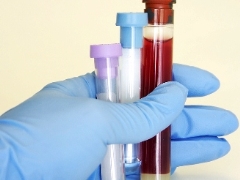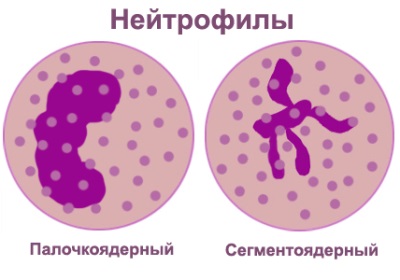Reduced neutrophils in the blood of a child
If a child's blood counts change, this is alarming for parents and is a reason to consult a doctor. One such disturbing change is the reduced neutrophil count. Why are such blood cells reduced and is this a danger to the health of the child?
What level of neutrophils is considered reduced
Neutrophils are the most numerous group of white blood cells, the main function of which is to destroy pathogenic bacteria. They are presented in several forms:
- Young neutrophils which are also called myelocytes and metamyelocytes. There are no such cells in the normal leukocyte formula.
- Band neutrophils (rods). These are young cells, the lower limit of the norm of which in the first days of life is 5%, and from the 5th day after birth - 1%.
- Segmental neutrophils. Such mature cells are predominant among all neutrophils and do not normally fall below these indicators:
|
Have a newborn |
50% |
|
From the fifth day after birth |
35% |
|
Baby 1 month |
17% |
|
One year old child |
20% |
|
The child is 5 years old |
35% |
|
In children over 10 years old |
40% |
If fewer neutrophils are detected in the blood of a small patient than should be at his age, this is called neutropenia.
Causes of Neutropenia
An insufficient number of neutrophils in a child’s blood can be caused by:
- Violation of the formation of such cells in the bone marrow.
- The destruction of this type of leukocytes in the blood due to the attack of harmful microbes or other negative effects.
- An increase in the number of lymphocytes due to infection with viruses. At the same time, the actual number of neutrophils does not decrease, but in percentage terms it will be below the norm.
Low neutrophil levels are diagnosed with:
- The flu.
- Chickenpox
- Viral hepatitis.
- Anemia caused by a deficiency of B12 or iron.
- Aplastic anemia.
- Fungal infection.
- Rubella.
- Leukemia
- Anaphylactic shock.
- Condition after radio or chemotherapy.
- Violation of the pancreas.
- Hyperfunction of the spleen.
- Tumors of different localization.
- Thyrotoxicosis.
- The use of cytostatics, painkillers, anticonvulsants and some other drugs.
In rare cases, neutropenia in a child can be congenital. One of its variants is called Kostman's agranulocytosis. Kids inherit it in an autosomal recessive manner. The main danger of this disease is the extremely low number of neutrophils and the high risk of developing infections that threaten the life of the infant.
Congenital neutropenia, also referred to as cyclic, is also encountered. This name is due to a periodic (about once every three weeks) decrease in neutrophils in the bloodstream. The course of this hereditary pathology is more favorable.
In addition, children younger than two years are often diagnosed with benign neutropenia. It can develop in the first months of life, but almost always passes by 2 years of age. Against the background of a decrease in the level of neutrophilic leukocytes, the general condition of such babies is satisfactory, and the growth and development processes are not disturbed.
Symptoms
Why is neutropenia dangerous?
What to do
Before starting treatment of a child with neutropenia, it is important to establish the reason for the decrease in this indicator. For this The pediatrician should show the baby for the doctor to examine and appoint additional examinations.. The child will certainly be sent for a second blood test with a decryption of the leukogram in order to exclude an erroneous result.
After the diagnosis, the child will be assigned the necessary therapy:
- If the cause of neutropenia is an infection, treatment will be directed to the destruction of the pathogen. With many viral diseases, therapy is designed to support the children's body and help it cope with the infectious agent itself. The task of the parents will be to provide the child with optimal conditions and an enhanced drinking regime. If bacteria provoke the disease, the doctor will select the desired antimicrobial drug.
- In case of Kostman’s disease, antibacterial agents are prescribed for the prevention of dangerous infections, as well as drugs that stimulate neutrophil formation in the bone marrow. In some cases, you have to perform a bone marrow transplant.
- With benign neutropenia, when lowered blood counts are not accompanied by any clinical symptoms, the child is further examined to exclude other causes of neutrophil decline, and then they are registered with a pediatrician and hematologist. The crumb is observed until such neutropenia passes on its own.
- If the cause of neutropenia is scarce anemia, therapy will be aimed at filling the nutritional deficiencies due to which anemia has developed. For example, in case of iron deficiency anemia, the child must be given iron supplements. In addition, parents should correct the diet of their son or daughter, taking into account the recommendations of the pediatrician.
- With toxic neutropenia caused by medicationthat provoked a decrease in neutrophils drugs are canceled, after which they prescribe medications that support the children's body.
You can learn more about neutrophils by watching the following video.
















